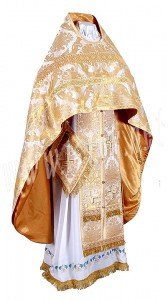 In the last issue of this article, I began to share thoughts on how the very vestments of the priest links him to the assembly. I shared the meaning of the stikharion and the epitrakhilion. Such is also the case with the epimanikia (cuffs): the priest’s hands, with which he blesses and performs the service, are no longer his own but the hands of Christ. The belt has always been a sign of obedience, preparedness, brotherhood and, of course, service. The priest does not take himself to the “high places” on his own authority; he “is not greater than his master.” Rather, he is sent to this ministry by his master, whom he follows and by whose grace he serves. Finally, the phelonion (chasuble) represents the glory of the Church as the new creation, the joy, truth and beauty of the new life, that is the prefiguration of the kingdom of God and the King who forever “reigns; he is robed in majesty”
In the last issue of this article, I began to share thoughts on how the very vestments of the priest links him to the assembly. I shared the meaning of the stikharion and the epitrakhilion. Such is also the case with the epimanikia (cuffs): the priest’s hands, with which he blesses and performs the service, are no longer his own but the hands of Christ. The belt has always been a sign of obedience, preparedness, brotherhood and, of course, service. The priest does not take himself to the “high places” on his own authority; he “is not greater than his master.” Rather, he is sent to this ministry by his master, whom he follows and by whose grace he serves. Finally, the phelonion (chasuble) represents the glory of the Church as the new creation, the joy, truth and beauty of the new life, that is the prefiguration of the kingdom of God and the King who forever “reigns; he is robed in majesty”
When we assemble as the Church we are clothed in the garments of the new creation. The priest, who truly represents the assembly, is the one who symbolizes this by the vestments that he wears during the services.
If assembling as the Church is, in the most profound sense of the term, the beginning of the Eucharistic celebration, its first and fundamental condition, then its end and completion is the Church’s entrance into heaven, her fulfillment at the table of Christ, in his kingdom. It is imperative to indicate and to confess that this as the sacrament’s end, purpose and fulfillment immediately after confessing the assembly as the Church as its beginning because this end also reveals the unity of the eucharist, its order and essence as movement and ascent – as, above all and before all, the sacrament of the kingdom of God. And it is no accident, of course, that in its present form the liturgy begins with the solemn blessing of the Kingdom. We begin the Divine Liturgy with the very solemn proclamation: Blessed is the Kingdom of the Father and the Son and the Holy Spirit, now and ever and forever. The total assembly responses to this beginning proclamation with a resounding AMEN, which is the Hebrew-Aramaic word for SO BE IT! We jointly declare that what we do together is make present God’s own Kingdom. WOW!
